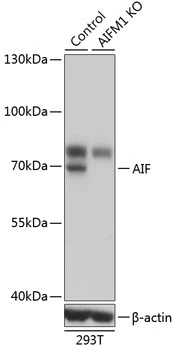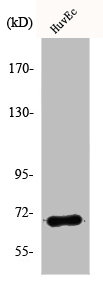![ELISA analysis of antigen using GTX60476 AIF antibody [4E7]. Red : Control antigen 100ng Purple : Antigen 10ng Green : Antigen 50ng Blue : Antigen 100ng ELISA analysis of antigen using GTX60476 AIF antibody [4E7]. Red : Control antigen 100ng Purple : Antigen 10ng Green : Antigen 50ng Blue : Antigen 100ng](https://www.genetex.com/upload/website/prouct_img/normal/GTX60476/GTX60476_20170912_ELISA_w_23061123_899.webp)
ELISA analysis of antigen using GTX60476 AIF antibody [4E7]. Red : Control antigen 100ng Purple : Antigen 10ng Green : Antigen 50ng Blue : Antigen 100ng
AIF antibody [4E7]
GTX60476
ApplicationsFlow Cytometry, ImmunoFluorescence, Western Blot, ELISA, ImmunoCytoChemistry, ImmunoHistoChemistry, ImmunoHistoChemistry Paraffin
Product group Antibodies
TargetAIFM1
Overview
- SupplierGeneTex
- Product NameAIF antibody [4E7]
- Delivery Days Customer9
- Application Supplier NoteWB: 1/500 - 1/2000. ICC/IF: 1/200 - 1/1000. IHC-P: 1/200 - 1/1000. FACS: 1/200 - 1/400. ELISA: 1/10000. *Optimal dilutions/concentrations should be determined by the researcher.Not tested in other applications.
- ApplicationsFlow Cytometry, ImmunoFluorescence, Western Blot, ELISA, ImmunoCytoChemistry, ImmunoHistoChemistry, ImmunoHistoChemistry Paraffin
- CertificationResearch Use Only
- ClonalityMonoclonal
- ConjugateUnconjugated
- Gene ID9131
- Target nameAIFM1
- Target descriptionapoptosis inducing factor mitochondria associated 1
- Target synonymsAIF, AUNX1, CMT2D, CMTX4, COWCK, COXPD6, DFNX5, NADMR, NAMSD, PDCD8, SEMDHL, apoptosis-inducing factor 1, mitochondrial, apoptosis-inducing factor, mitochondrion-associated, 1, auditory neuropathy, X-linked recessive 1, programmed cell death 8 (apoptosis-inducing factor), striatal apoptosis-inducing factor, testicular secretory protein Li 4
- HostMouse
- IsotypeIgG2b
- Protein IDO95831
- Protein NameApoptosis-inducing factor 1, mitochondrial
- Scientific DescriptionThis gene encodes a flavoprotein essential for nuclear disassembly in apoptotic cells, and it is found in the mitochondrial intermembrane space in healthy cells. Induction of apoptosis results in the translocation of this protein to the nucleus where it affects chromosome condensation and fragmentation. In addition, this gene product induces mitochondria to release the apoptogenic proteins cytochrome c and caspase-9. Mutations in this gene cause combined oxidative phosphorylation deficiency 6, which results in a severe mitochondrial encephalomyopathy. Alternative splicing results in multiple transcript variants. A related pseudogene has been identified on chromosome 10. [provided by RefSeq, May 2010]
- Storage Instruction-20°C or -80°C,2°C to 8°C
- UNSPSC12352203

![FACS analysis of HepG2 cells using GTX60476 AIF antibody [4E7]. Blue : AIF Red : negative control FACS analysis of HepG2 cells using GTX60476 AIF antibody [4E7]. Blue : AIF Red : negative control](https://www.genetex.com/upload/website/prouct_img/normal/GTX60476/GTX60476_20170912_FACS_w_23061123_349.webp)
![ICC/IF analysis of NIH3T3 cells using GTX60476 AIF antibody [4E7]. Green : AIF Blue: DRAQ5 fluorescent DNA dye Red: Actin filaments ICC/IF analysis of NIH3T3 cells using GTX60476 AIF antibody [4E7]. Green : AIF Blue: DRAQ5 fluorescent DNA dye Red: Actin filaments](https://www.genetex.com/upload/website/prouct_img/normal/GTX60476/GTX60476_20170912_ICCIF_w_23061123_573.webp)
![IHC-P analysis of human cervical cancer tissue using GTX60476 AIF antibody [4E7]. IHC-P analysis of human cervical cancer tissue using GTX60476 AIF antibody [4E7].](https://www.genetex.com/upload/website/prouct_img/normal/GTX60476/GTX60476_20170912_IHC-P_1_w_23061123_878.webp)
![IHC-P analysis of human lung cancer tissue using GTX60476 AIF antibody [4E7]. IHC-P analysis of human lung cancer tissue using GTX60476 AIF antibody [4E7].](https://www.genetex.com/upload/website/prouct_img/normal/GTX60476/GTX60476_20170912_IHC-P_2_w_23061123_584.webp)
![IHC-P analysis of human rectum cancer tissue using GTX60476 AIF antibody [4E7]. IHC-P analysis of human rectum cancer tissue using GTX60476 AIF antibody [4E7].](https://www.genetex.com/upload/website/prouct_img/normal/GTX60476/GTX60476_20170912_IHC-P_3_w_23061123_474.webp)
![IHC-P analysis of human breast cancer tissue using GTX60476 AIF antibody [4E7]. IHC-P analysis of human breast cancer tissue using GTX60476 AIF antibody [4E7].](https://www.genetex.com/upload/website/prouct_img/normal/GTX60476/GTX60476_20170912_IHC-P_w_23061123_579.webp)
![WB analysis of NIH3T3 (1), Jurkat (2), HeLa (3), HepG2 (4), MOLT4 (5), C6 (6), RAJI (7), Cos7 (8) and PC-12 (9) cell lysate using GTX60476 AIF antibody [4E7]. WB analysis of NIH3T3 (1), Jurkat (2), HeLa (3), HepG2 (4), MOLT4 (5), C6 (6), RAJI (7), Cos7 (8) and PC-12 (9) cell lysate using GTX60476 AIF antibody [4E7].](https://www.genetex.com/upload/website/prouct_img/normal/GTX60476/GTX60476_20170912_WB_w_23061123_588.webp)
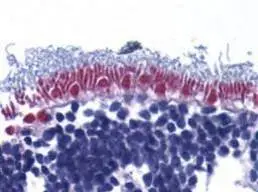
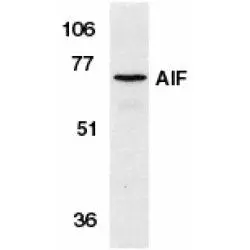
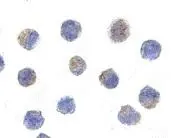
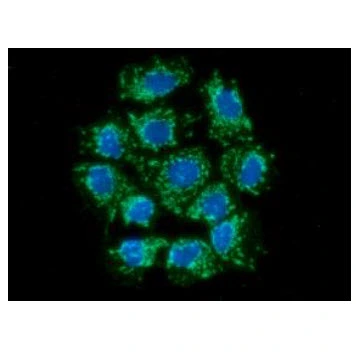
![IHC-P analysis of hmuan oophoroma tissue section using GTX00833 AIF antibody [GT1143]. Dlution : 1:100](https://www.genetex.com/upload/website/prouct_img/normal/GTX00833/GTX00833_20191101_AP_003_42_w_23053121_674.webp)
